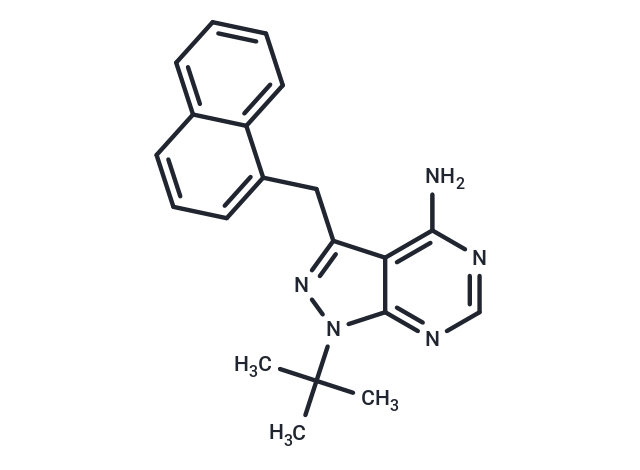Shopping Cart
Remove All Your shopping cart is currently empty
Your shopping cart is currently empty
1-NM-PP1 (PP1 Analog II) is a cell-permeable PP1 analog that acts as a potent and selective inhibitor of mutant kinases over their wild-type progenitors.

| Pack Size | Price | USA Warehouse | Global Warehouse | Quantity |
|---|---|---|---|---|
| 1 mg | $43 | In Stock | In Stock | |
| 2 mg | $60 | In Stock | In Stock | |
| 5 mg | $81 | In Stock | In Stock | |
| 10 mg | $142 | In Stock | In Stock | |
| 25 mg | $302 | In Stock | In Stock | |
| 50 mg | $560 | In Stock | In Stock | |
| 100 mg | $743 | In Stock | In Stock | |
| 1 mL x 10 mM (in DMSO) | $87 | In Stock | In Stock |
| Description | 1-NM-PP1 (PP1 Analog II) is a cell-permeable PP1 analog that acts as a potent and selective inhibitor of mutant kinases over their wild-type progenitors. |
| Targets&IC50 | PKD:0.398 μM |
| In vitro | Cdk7 from both mutant (Cdk7as/as) and wild-type (Cdk7+/+) cells was immunoprecipitated to assess its kinase activity on a Pol II CTD-containing fusion protein (GST-CTD) and human Cdk2. Interestingly, Cdk7 extracted from mutant cells, unlike that from wild-type cells, showed susceptibility to inhibition by 1-NM-PP1 (1-NMPP1), demonstrating an inhibitory concentration 50 (IC50) of approximately 50 nM for both substrates. Moreover, mutant HCT116 cells replaced with wild-type Cdk7 became sensitive to 1-NM-PP1, affecting growth. In the absence of 1-NM-PP1, both wild-type and mutant cells exhibited similar cell-cycle distributions and population doubling times (approximately 17.9 and 20.2 hours, respectively), indicating the F91g mutation alone minimally impacts Cdk7 function. However, mutant cells, but not wild-type, exhibited sensitivity to 1-NM-PP1 with an IC50 of approximately 100 nM, as determined by cell viability (MTT) assays after prolonged (96-hour) exposure. Additionally, 10 μM of 1-NM-PP1 hindered G1/S phase progression in mutant but not wild-type cells, with immediate effects observed when 1-NM-PP1 was introduced alongside serum, halting S phase entry for 15 hours. Even after releasing the mutant cells from serum starvation into a medium with 1-NM-PP1, there was a delayed and partial progression into S phase, while a fraction remained in G1. Further experimentation revealed that introducing 1-NM-PP1 3 or 6 hours post serum addition delayed S-phase entry by approximately 7 and 3 hours, respectively. |
| Kinase Assay | Immunoblotting and immunoprecipitation, and kinase assays of immune complexes, are carried out. To measure Cdk1/cyclin B assembly, extracts (200 μg total protein) from cells in mitosis or G2 are pre-incubated with 2 μM 1-NM-PP1 or DMSO, then added 500 ng purified cyclin B1, amino-terminally tagged with hexahistidine and the Myc epitope, and an ATP-regenerating system. Where indicated, incubations are supplemented with 400 ng purified Csk1 or 600 ng wild-type or analog-sensitive, T-loop-phosphorylated Cdk7/cyclin H/Mat1 complex. After 90 min at room temperature, Myc-cyclin B and associated proteins are immunoprecipitated with anti-Myc antibodies and immune complexes are subjected to immunoblotting, with anti-Myc and anti-Cdk1 antibodies, and tested for histone H1 kinase activity[1]. |
| Cell Research | 1-NM-PP1 (1-NMPP1) is dissolved in DMSO and stored, and then diluted with appropriate media before use[1]. Wild-type or Cdk7as/as HCT116 cells are synchronized by incubation in serum-free medium for 48 h and released into medium containing 10% fetal calf serum. Synchronization with thymidine or nocodazole, and analysis of cell-cycle distribution by flow cytometry, are performed. Cell viability is measured by MTT assay[1]. |
| Synonyms | PP1 Analog II, 1 nM-PP1 |
| Molecular Weight | 331.41 |
| Formula | C20H21N5 |
| Cas No. | 221244-14-0 |
| Smiles | CC(C)(C)n1nc(Cc2cccc3ccccc23)c2c(N)ncnc12 |
| Relative Density. | 1.25 g/cm3 (Predicted) |
| Color | White |
| Appearance | Solid |
| Storage | Powder: -20°C for 3 years | In solvent: -80°C for 1 year | Shipping with blue ice/Shipping at ambient temperature. | |||||||||||||||||||||||||||||||||||
| Solubility Information | DMSO: 45 mg/mL (135.78 mM), Sonication is recommended. | |||||||||||||||||||||||||||||||||||
| In Vivo Formulation | 10% DMSO+40% PEG300+5% Tween 80+45% Saline: 2 mg/mL (6.03 mM), Sonication is recommended. Please add the solvents sequentially, clarifying the solution as much as possible before adding the next one. Dissolve by heating and/or sonication if necessary. Working solution is recommended to be prepared and used immediately. The formulation provided above is for reference purposes only. In vivo formulations may vary and should be modified based on specific experimental conditions. | |||||||||||||||||||||||||||||||||||
Solution Preparation Table | ||||||||||||||||||||||||||||||||||||
DMSO
| ||||||||||||||||||||||||||||||||||||
| Size | Quantity | Unit Price | Amount | Operation |
|---|

Copyright © 2015-2025 TargetMol Chemicals Inc. All Rights Reserved.